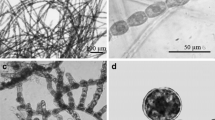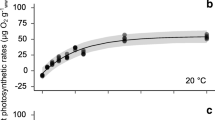Abstract
Six geographical isolates of Rhodochorton purpureum (Lightfoot) Rosenvinge (Rhodophyta, Nemalionales) formed tetrasporangia only in short days at 10°C. For most isolates, the critical day-length increased with latitude of origin from 9.5 h for an isolate from California to 14.5 h for one from Antarctica. Tetrasporangium production could be induced by 9–15 short-day cycles followed by a further 22–28 cycles in long days. A night-break consisting of 1 h of white light in the middle of a 16-h dark period inhibited the short-day response of isolates from low latitudes, but not those from higher latitudes. When a similar night-break was given in the middle of a 14-h dark period, however, the response of all isolates was at least partially inhibited. Night-breaks given at any time in the central 7 h of a 14-h dark period were equally inhibitory. Broad-band red light (0.3–0.4 mmol m-2), given as a night-break, caused 50% inhibition of the short-day response. At a slightly higher photon exposure (0.6 mmol m-2, given as 1 μmol m-2 s-1 for 10 min), narrow-band red (662 nm) and blue (448 nm) light caused similar inhibition, but green (547 nm) and far-red (731 nm) were ineffective as night-breaks. The inhibitory effect of a 10-min night-break with red light could not be reversed by subsequent exposure to an equal photon exposure of far-red light. These results add to the existing evidence that the pigments mediating photoperiodic responses among algae are more varied than those among flowering plants.
Similar content being viewed by others
Abbreviations
- LD:
-
long day
- SD:
-
short day
References
Abdel-Rahman, M.H. (1982a) Photopériodisme chéz Acrochaetium asparagopsis (Rhodophycées). I. Réponse à une photopériode de jours courts au cours de la formation de tetrasporocystes. Physiol. Vég. 20, 155–164
Abdel-Rahman, M.H. (1982b) Photopérodisme chéz Acrochaetium asparagopsis (Rhodophycées, Acrochaetiales). Influence de l'interruption de la nyctipériode, par un éclairement blanc ou monochromatique, sur la formation des tetrasporocystes. C.R. Acad. Sci. Paris, Ser. III 294, 389–392
Cortel-Breeman, A.M., ten Hopen, A. (1978) The short-day response in Acrosymphyton purpuriferum (J. Ag.) Sjost. (Rhodophyceae. Cryptonemiales). Phycologia 17, 125–132
Dring, M.J. (1967) Phytochrome in red alga, Porphyra tenera. Nature (London) 215, 1411–1412
Dring, M.J. (1970) Photoperiodic effects in microorganisms. In: Photobiology of microorganisms, pp. 345–368, Halldal, P., ed. Wiley, London
Dring, M.J., Lüning, K. (1975) A photoperiodic effect mediated by blue light in the brown alga Scytosiphon lomentaria. Planta 125, 25–32
Dring, M.J., Lüning, K. (1983) Photomorphogenesis of marine macroalgac. In: Encyclopedia of plant physiology, N.S., vol. 16: Photomorphogenesis, pp. 545–568, Shropshire, W., Mohr, H., eds. Springer, Berlin Heidelberg New York
Lüning, K. (1980) Control of algal life history by daylength and temperature. In: The shore environment, vol. 2: Ecosystems, pp. 915–945, Price, J.H., Irvine, D.E.G., Farnham, W.F., (eds.) Academic Press, London New York
McMillan, C. (1974) Photoperiodic responses of Xanthium strumarium L. (Compositae) introduced and indigenous in Eastern Asia. Am. J. Bot. 57, 881–888
Parker, M.W., Hendricks, S.B., Borthwick, H.A. (1950) Action spectrum for the photoperiodic control of floral initiation of the long-day plant Hyoscyamus niger. Bot. Gaz. (Chicago) 111, 242–252
Provasoli, L. (1968) Media and prospects for the cultivation of marine algae. In: Cultures and collections of algae, pp. 63–75, Watanabe, A., Hattori, A. (eds) Japanese Society of Plant Physiology, Tokyo
Rentschler, H.-G. (1967) Photoperiodische Induktion der Monosporenbildung bei Porphyra tenera Kjellm. (Rhodophyta — Bangiophyceae). Planta 76, 65–74
Rietema, H., Breeman, A.M. (1982) The regulation of the life history of Dumontia contorta in comparison to that of several other Dumontiaceae (Rhodophyta). Bot. Mar. 25, 569–576
Salisbury, F.B., Bonner, J. (1956) The reactions of the photoinductive dark period. Plant Physiol. 31, 141–147
Terry, L.A., Moss, B.L. (1980) The effect of photoperiod on receptacle initiation in Ascophyllum nodosum (L.) Le Jol. Br. Phycol. J. 15, 291–301
Vince-Prue, D. (1975) Photoperiodism in plants. McGraw-Hill, London
Vince-Prue, D. (1976) Phytochrome and photoperiodism. In: Light and plant development, pp. 347–369, Smith, H., ed. Butterworths, London
West, J.A. (1972) Environmental regulation of reproduction in Rhodochorton purpureum. In: Contributions to the systematics of benthic marine algae of the North Pacific, pp. 213–230, Abbott, I.A., Kurogi, M., eds, Japanese Society of Phycology, Kobe
Woelkerling, W. (1973) The morphology and systematics of the Audouinella complex (Acrochaetiales, Rhodophyta) in north-eastern United States. Rhodora 75, 529–621
Author information
Authors and Affiliations
Rights and permissions
About this article
Cite this article
Dring, M.J., West, J.A. Photoperiodic control of tetrasporangium formation in the red alga Rhodochorton purpureum . Planta 159, 143–150 (1983). https://doi.org/10.1007/BF00392985
Received:
Accepted:
Issue Date:
DOI: https://doi.org/10.1007/BF00392985




